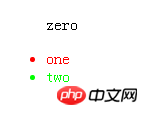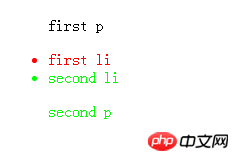關於CSS3中nth-child和nth-of-type的區別詳解
- 黄舟原創
- 2017-06-01 10:41:291813瀏覽
CSS3中nth-child與nth-of-type的差別其實很簡單::nth-of-type為什麼要叫:nth-of-type?因為它是以"type"來區分的。也就是說:ele:nth-of-type(n)是指父元素下第n個ele元素, 而ele:nth-child(n)是指父元素下第n個元素且這個元素為ele,若不是,則選擇失敗。
文字未免聽起來比較晦澀,便於理解,這裡附上一個小例子:
<!DOCTYPE html>
<html lang="en">
<head>
<meta charset="UTF-8">
<title>demo</title>
</head>
<style>
.demo li:nth-child(2){
color: #ff0000;
}
.demo li:nth-of-type(2){
color: #00ff00;
}
</style>
<body>
<p>
<ul class="demo">
<p>zero</p>
<li>one</li>
<li>two</li>
</ul>
</p>
</body>
</html>
結果如下: 
上面這個例子,.demo li:nth-child(2)選擇的是25edfb22a4f469ecb59f1190150159c6onebed06894275b65c1ab86501b08a632eb節點,而.demo li:nth-of-type(2)則選擇的是< ;li>twobed06894275b65c1ab86501b08a632eb節點。
但是如果在nth-child和 nth-of-type前不指定標籤呢?
.demo :nth-child(2){
color: #ff0000;
}
.demo :nth-of-type(2){
color: #00ff00;
}
這樣又會是什麼結果呢,請看html結構:
<ul class="demo"> <p>first p</p> <li>first li</li> <li>second li</li> <p>second p</p> </ul>
##結果:

如上可見,在他們之前不指定標籤類型,:nth-child(2) 選取依舊是第二個元素,無論它是什麼標籤。而:nth-type-of(2) 選取了兩個元素,分別是父級.demo中的第二個p標籤和第二個li標籤,由此可見,不指定標籤類型時,:nth-type -of(2)會選取所有類型標籤的第二個。
我們已經了解了nth-child和nth-of-type的
基本使用與區別,那麼更進一步nth-of-type(n)與nth-child(n)中的n是什麼呢?
nth-of-type(n)與nth-child(n)中的n可以是數字、關鍵字或公式。 數字:也就是上面例子的使用,就不做贅述。 關鍵字:Odd 、even
Odd 和even 是可用來匹配下標是奇數或偶數的子元素的關鍵字
注意:第一個子元素的下標是1
在這裡,我們為奇數和偶數p 元素指定兩種不同的背景色:
p:nth-of-type(odd)
{
background:#ff0000;
}
p:nth-of-type(even)
{
background:#0000ff;
}公式:或者說是算術表達式
使用公式(an + b)。描述:表示週期的長度,n 是計數器(從 0 開始),b 是偏移值。
在這裡,我們指定了下標是3 的倍數的所有p 元素的背景色:
p:nth-of-type(3n+0)
{
background:#ff0000;
}若是:nth-of-type(4n+2) 就是選擇下標是4的倍數加上2的所有元素
總結
以上是關於CSS3中nth-child和nth-of-type的區別詳解的詳細內容。更多資訊請關注PHP中文網其他相關文章!

